Material adapted and updated for this website from:
Velicer, W. F, Prochaska, J. O., Fava, J. L., Norman, G. J., & Redding, C. A. (1998). Smoking cessation and stress management: Applications of the Transtheoretical Model of behavior change. Homeostasis, 38, 216-233.
This is an overview of the Transtheoretical Model of Change, a theoretical model of behavior change, which has been the basis for developing effective interventions to promote health behavior change. The Transtheoretical Model (Prochaska & DiClemente, 1983; Prochaska, DiClemente, & Norcross, 1992; Prochaska & Velicer, 1997) is an integrative model of behavior change. Key constructs from other theories are integrated. The model describes how people modify a problem behavior or acquire a positive behavior. The central organizing construct of the model is the Stages of Change. The model also includes a series of independent variables, the Processes of Change, and a series of outcome measures, including the Decisional Balance and the Temptation scales. The Processes of Change are ten cognitive and behavior activities that facilitate change. This model will be described in greater detail below.
The Transtheoretical Model is a model of intentional change. It is a model that focuses on the decision making of the individual. Other approaches to health promotion have focused primarily on social influences on behavior or on biological influences on behavior. For smoking, an example of social influences would be peer influence models (Flay, 1985) or policy changes (Velicer, Laforge, Levesque, & Fava, 1994). An example of biological influences would be nicotine regulation models (Leventhal & Cleary, 1980; Velicer, Redding, Richmond, Greeley, & Swift, 1992) and replacement therapy (Fiore. Smith, Jorenby, & Baker, 1994). Within the context of the Transtheoretical Model, these are viewed as external influences, impacting through the individual.
The model involves emotions, cognitions, and behavior. This involves a reliance on self-report. For example, in smoking cessation, self-report has been demonstrated to be very accurate (Velicer, Prochaska, Rossi, & Snow 1992). Accurate measurement requires a series of unambiguous items that the individual can respond to accurately with little opportunity for distortion. Measurement issues are very important and one of the critical steps for the application of the model involves the development of short, reliable, and valid measures of the key constructs.
This paper will demonstrate applications of the Transtheoretical Model. The model has previously been applied to a wide variety of problem behaviors. These include smoking cessation, exercise, low fat diet, radon testing, alcohol abuse, weight control, condom use for HIV protection, organizational change, use of sunscreens to prevent skin cancer, drug abuse, medical compliance, mammography screening, and stress management. Two of these applications will be described in detail, smoking cessation and stress management. The former represents a well-researched area where multiple tests of the model are available and effective interventions based on the model have been developed and evaluated in multiple clinical trials. The latter represents a problem area where research based on the Transtheoretical Model is in the formative stages.
Stages of Change: The Temporal Dimension
The stage construct is the key organizing construct of the model. It is important in part because it represents a temporal dimension. Change implies phenomena occurring over time. However, this aspect was largely ignored by alternative theories of change. Behavior change was often construed as an event, such as quitting smoking, drinking, or over-eating. The Transtheoretical Model construes change as a process involving progress through a series of five stages.
Precontemplation is the stage in which people are not intending to take action in the foreseeable future, usually measured as the next six months. People may be in this stage because they are uninformed or under-informed about the consequences of their behavior. Or they may have tried to change a number of times and become demoralized about their ability to change. Both groups tend to avoid reading, talking or thinking about their high risk behaviors. They are often characterized in other theories as resistant or unmotivated or as not ready for health promotion programs. The fact is traditional health promotion programs are often not designed for such individuals and are not matched to their needs.
Contemplation is the stage in which people are intending to change in the next six months. They are more aware of the pros of changing but are also acutely aware of the cons. This balance between the costs and benefits of changing can produce profound ambivalence that can keep people stuck in this stage for long periods of time. We often characterize this phenomenon as chronic contemplation or behavioral procrastination. These people are also not ready for traditional action oriented programs.
Preparation is the stage in which people are intending to take action in the immediate future, usually measured as the next month. They have typically taken some significant action in the past year. These individuals have a plan of action, such as joining a health education class, consulting a counselor, talking to their physician, buying a self-help book or relying on a self-change approach. These are the people that should be recruited for action- oriented smoking cessation, weight loss, or exercise programs.
Action is the stage in which people have made specific overt modifications in their life-styles within the past six months. Since action is observable, behavior change often has been equated with action. But in the Transtheoretical Model, Action is only one of five stages. Not all modifications of behavior count as action in this model. People must attain a criterion that scientists and professionals agree is sufficient to reduce risks for disease. In smoking, for example, the field used to count reduction in the number of cigarettes as action, or switching to low tar and nicotine cigarettes. Now the consensus is clear–only total abstinence counts. In the diet area, there is some consensus that less than 30% of calories should be consumed from fat. The Action stage is also the stage where vigilance against relapse is critical.
Maintenance is the stage in which people are working to prevent relapse but they do not apply change processes as frequently as do people in action. They are less tempted to relapse and increasingly more confident that they can continue their change.
Figure 1 illustrates how the temporal dimension is represented in the model. Two different concepts are employed. Before the target behavior change occurs, the temporal dimension is conceptualized in terms of behavioral intention. After the behavior change has occurred, the temporal dimension is conceptualized in terms of duration of behavior.
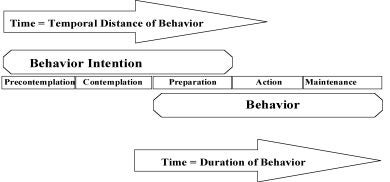
Regression occurs when individuals revert to an earlier stage of change. Relapse is one form of regression, involving regression from Action or Maintenance to an earlier stage. However, people can regress from any stage to an earlier stage. The bad news is that relapse tends to be the rule when action is taken for most health behavior problems. The good news is that for smoking and exercise only about 15% of people regress all the way to the Precontemplation stage. The vast majority regress to Contemplating or Preparation.
In a recent study (Velicer, Fava, Prochaska, Abrams, Emmons, & Pierce, 1995), it was demonstrated that the distribution of smokers across the first three Stages of Change was approximately identical across three large representative samples. Approximately 40% of the smokers were in the Precontemplation stage, 40% were in the Contemplation stage, and 20% were in the Preparation stage.
However, the distributions may be different in different countries. A recent paper (Etter, Perneger, & Ronchi, 1997) summarized the stage distributions from four recent samples from different countries in Europe (one each from Spain and the Netherlands, and two from Switzerland). The distributions were very similar across the European samples but very different from the American samples. In the European samples, approximately 70% of the smokers were in the Precontemplation stage, 20% were in the Contemplation stage, and 10% were in the Preparation stage.
While the stage distributions for smoking cessation have now been established in multiple samples, the stage distributions for other problem behaviors are not as well known. This is particularly true for countries other than the United States.
Intermediate/Dependent Measures: Determining when Change Occurs
The Transtheoretical Model also involves a series of intermediate/outcome measures. Typical theories of change involve only a single univariate outcome measure of success, often discrete. Point prevalence smoking cessation (Velicer, Prochaska, Rossi, & Snow, 1992) is an example from smoking cessation research. Such measures have low power, i. e., a limited ability to detect change. They are also not sensitive to change over all the possible stage transitions. For example, point prevalence for smoking cessation would be unable to detect an individual who progresses from Precontemplation to Contemplation or from Contemplation to Preparation or from Action to Maintenance. In contrast, the Transtheoretical Model proposes a set of constructs that form a multivariate outcome space and includes measures that are sensitive to progress through all stages. These constructs include the Pros and Cons from the Decisional Balance Scale, Self-efficacy or Temptation, and the target behavior. A more detailed presentation of this aspect to the model is provided elsewhere (Velicer, Prochaska, Rossi, & DiClemente, 1996).
Decisional Balance. The Decisional Balance construct reflects the individual’s relative weighing of the pros and cons of changing. It is derived from the Janis and Mann’s model of decision making (Janis and Mann, 1985) that included four categories of pros (instrumental gains for self and others and approval for self and others). The four categories of cons were instrumental costs to self and others and disapproval from self and others. However, an empirical test of the model resulted in a much simpler structure. Only two factors, the Pros and Cons, were found (Velicer, DiClemente, Prochaska, & Brandenberg, 1985). In a long series of studies (Prochaska, et al. 1994), this much simpler structure has always been found.
The Decisional Balance scale involves weighting the importance of the Pros and Cons. A predictable pattern has been observed of how the Pros and Cons relate to the stages of change. Figure 2 illustrates this pattern for smoking cessation. In Precontemplation, the Pros of smoking far outweigh the Cons of smoking. In Contemplation, these two scales are more equal. In the advanced stages, the Cons outweigh the Pros.
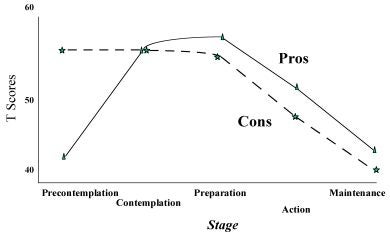
A different pattern has been observed for the acquisition of healthy behaviors. Figure 3 illustrates this pattern for exercise. The patterns are similar across the first three stages. However, for the last two stages, the Pros of exercising remain high. This probably reflects the fact that maintaining a program of regular exercise requires a continual series of decisions while smoking eventually becomes irrelevant. These two scales capture some of the cognitive changes that are required for progress in the early stages of change.
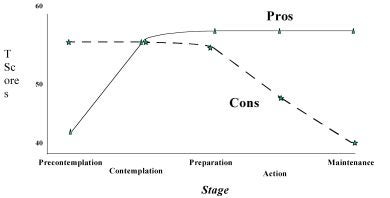
Self-efficacy/Temptations. The Self-efficacy construct represents the situation specific confidence that people have that they can cope with high-risk situations without relapsing to their unhealthy or high-risk habit. This construct was adapted from Bandura’s self-efficacy theory (Bandura, 1977, 1982). This construct is represented either by a Temptation measure or a Self-efficacy construct.
The Situational Temptation Measure (DiClemente, 1981, 1986; Velicer, DiClemente, Rossi, & Prochaska, 1990) reflects the intensity of urges to engage in a specific behavior when in the midst of difficult situations. It is, in effect, the converse of self-efficacy and the same set of items can be used to measure both, using different response formats. The Situational Self-efficacy Measure reflects the confidence of the individual not to engage in a specific behavior across a series of difficult situations.
Both the Self-efficacy and Temptation measures have the same structure (Velicer et al., 1990). In our research we typically find three factors reflecting the most common types of tempting situations: negative affect or emotional distress, positive social situations, and craving. The Temptation/Self-efficacy measures are particularly sensitive to the changes that are involved in progress in the later stages and are good predictors of relapse.
Self-efficacy can be represented by a monotonically increasing function across the five stages. Temptation is represented by a monotonically decreasing function across the five stages. Figure 4 illustrates the relation between stage and these two constructs.
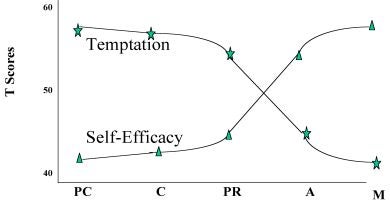
Independent Measures: How Change Occurs
Processes of Change are the covert and overt activities that people use to progress through the stages. Processes of change provide important guides for intervention programs, since the processes are the independent variables that people need to apply, or be engaged in, to move from stage to stage. Ten processes (Prochaska & DiClemente, 1983; Prochaska, Velicer, DiClemente, & Fava, 1988) have received the most empirical support in our research to date. The first five are classified as Experiential Processes and are used primarily for the early stage transitions. The last five are labeled Behavioral Processes and are used primarily for later stage transitions. Table 1 provides a list of the processes with a sample item for each process from smoking cessation as well as alternative labels.
I. Processes of Change: Experiential
- Consciousness Raising [Increasing awareness]
I recall information people had given me on how to stop smoking - Dramatic Relief [Emotional arousal]
I react emotionally to warnings about smoking cigarettes - Environmental Reevaluation [Social reappraisal]
I consider the view that smoking can be harmful to the environment - Social Liberation [Environmental opportunities]
I find society changing in ways that make it easier for the nonsmoker - Self Reevaluation [Self reappraisal]
My dependency on cigarettes makes me feel disappointed in myself
II. Processes of Change: Behavioral
- Stimulus Control [Re-engineering]
I remove things from my home that remind me of smoking - Helping Relationship [Supporting]
I have someone who listens when I need to talk about my smoking - Counter Conditioning [Substituting]
I find that doing other things with my hands is a good substitute for smoking - Reinforcement Management [Rewarding]
I reward myself when I don’t smoke - Self Liberation [Committing]
I make commitments not to smoke
Table 1. The processes of change with alternative labels and sample items from smoking cessation
Consciousness Raising involves increased awareness about the causes, consequences and cures for a particular problem behavior. Interventions that can increase awareness include feedback, education, confrontation, interpretation, bibliotherapy and media campaigns.
Dramatic Relief initially produces increased emotional experiences followed by reduced affect if appropriate action can be taken. Psychodrama, role playing, grieving, personal testimonies and media campaigns are examples of techniques that can move people emotionally.
Environmental Reevaluation combines both affective and cognitive assessments of how the presence or absence of a personal habit affects one’s social environment such as the effect of smoking on others. It can also include the awareness that one can serve as a positive or negative role model for others. Empathy training, documentaries, and family interventions can lead to such re-assessments.
Social Liberation requires an increase in social opportunities or alternatives especially for people who are relatively deprived or oppressed. Advocacy, empowerment procedures, and appropriate policies can produce increased opportunities for minority health promotion, gay health promotion, and health promotion for impoverished people. These same procedures can also be used to help all people change such as smoke-free zones, salad bars in school lunches, and easy access to condoms and other contraceptives.
Self-reevaluation combines both cognitive and affective assessments of one’s self-image with and without a particular unhealthy habit, such as one’s image as a couch potato or an active person. Value clarification, healthy role models, and imagery are techniques that can move people evaluatively.
Stimulus Control removes cues for unhealthy habits and adds prompts for healthier alternatives. Avoidance, environmental re-engineering, and self-help groups can provide stimuli that support change and reduce risks for relapse. Planning parking lots with a two-minute walk to the office and putting art displays in stairwells are examples of reengineering that can encourage more exercise.
Helping Relationships combine caring, trust, openness and acceptance as well as support for the healthy behavior change. Rapport building, a therapeutic alliance, counselor calls and buddy systems can be sources of social support.
Counter Conditioning requires the learning of healthier behaviors that can substitute for problem behaviors. Relaxation can counter stress; assertion can counter peer pressure; nicotine replacement can substitute for cigarettes, and fat free foods can be safer substitutes.
Reinforcement Management provides consequences for taking steps in a particular direction. While reinforcement management can include the use of punishments, we found that self-changers rely on rewards much more than punishments. So reinforcements are emphasized, since a philosophy of the stage model is to work in harmony with how people change naturally. Contingency contracts, overt and covert reinforcements, positive self-statements and group recognition are procedures for increasing reinforcement and the probability that healthier responses will be repeated.
Self-liberation is both the belief that one can change and the commitment and recommitment to act on that belief. New Year’s resolutions, public testimonies, and multiple rather than single choices can enhance self-liberation or what the public calls willpower. Motivation research indicates that people with two choices have greater commitment than people with one choice; those with three choices have even greater commitment; four choices does not further enhance will power. So with smokers, for example, three excellent action choices they can be given are cold turkey, nicotine fading and nicotine replacement.
For smoking cessation, each of the processes is related to the stages of change by a curvilinear function. Process use is at a minimum in Precontemplation, increases over the middle stages, and then declines over the last stages. The processes differ in the stage where use reaches a peak. Typically, the experiential processes reach peak use early and the behavioral processes reach peak use late. Figure 5 illustrates the relation of process to stage for two processes, Consciousness Raising and Stimulus Control, exemplars of experiential and behavioral processes, respectively.
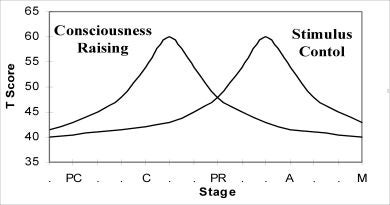
Summary
The Transtheoretical Model has general implications for all aspects of intervention development and implementation. We will briefly describe how it impacts on five areas: recruitment, retention, progress, process, and outcome.
The Transtheoretical Model is an appropriate model for the recruitment of an entire population. Traditional interventions often assume that individuals are ready for an immediate and permanent behavior change. The recruitment strategies reflect that assumption and, as a result, only a very small proportion of the population participates. In contrast, the Transtheoretical Model makes no assumption about how ready individuals are to change. It recognizes that different individuals will be in different stages and that appropriate interventions must be developed for everyone. As a result, very high participation rates have been achieved.
The Transtheoretical Model can result in high retention rates. Traditional interventions often have very high dropout rates. Participants find that there is a mismatch between their needs and readiness and the intervention program. Since the program is not fitting their needs, they quickly dropout. In contrast, the Transtheoretical Model is designed to develop interventions that are matched to the specific needs of the individual. Since the interventions are individualized to their needs, people much less frequently drop out because of inappropriate demand characteristics.
The Transtheoretical Model can provide sensitive measures of progress. Action oriented programs typically use a single, often discrete, measure of outcome. Any progress that does not reach criterion is not recognized. This is particularly a problem in the early stages where progress typically does not involve easily observed changes in overt patterns of behavior. In contrast, the Transtheoretical Model includes a set of outcome measures that are sensitive to a full range of cognitive, emotional, and behavioral changes and recognize and reinforce smaller steps than traditional action-oriented approaches.
The Transtheoretical Model can facilitate an analysis of the mediational mechanisms. Interventions are likely to be differentially effective. Given the multiple constructs and clearly defined relationships, the model can facilitate a process analysis and guide the modification and improvement of the intervention. For example, an analysis of the patterns of transition from one stage to another can determine if the intervention was more successful with individuals in one stage and not with individuals in another stage. Likewise, an analysis of process use can determine if the interventions were more successful in activating the use of some processes.
The Transtheoretical Model can support a more appropriate assessment of outcome. Interventions should be evaluated in terms of their impact, i.e., the recruitment rate times the efficacy. For example, a smoking cessation intervention could have a very high efficacy rate but a very low recruitment rate. This otherwise effective intervention would have very little impact on smoking rates in the population. In contrast, an intervention that is less effective but has a very high recruitment rate could have an important impact on smoking rates in the population. Interventions based on the Transtheoretical Model have the potential to have both a high efficacy and a high recruitment rate, thus dramatically increasing our potential impact on entire populations of individuals with behavioral health risks.
References
Bandura, A. (1977). Self-efficacy: Toward a unifying theory of behavior change. Psychological Review, 84, 191-215.
Bandura, A. (1982). Self-efficacy mechanism in human agency. American Psychologist, 37, 122-147.
Bollen, K. A. (1989). A new incremental fit index for general structural equation models. Sociological Methods of Research, 17, 303-316.
Botelho, R. J., Velicer, W. F., & Prochaska, J. O. (1998). Expert systems for motivating health behavior change: II. Evaluating the future prospects for dissemination. Manuscript under review.
Cohen, J. (1977). Statistical power analysis for the behavioral sciences (rev ed.). New York: Academic Press.
Cronbach, L. J., (1951). Coefficient alpha and the internal structure of tests. Psychometrika, 16, 297-334.
DiClemente, CC (1981). Self-efficacy and smoking cessation maintenance: A preliminary report. Cognitive Therapy and Research, 5, 175-187.
DiClemente, CC (1986). Self-efficacy and the addictive behaviors. Journal of Social and Clinical Psychology, 4, 302-315.
DiClemente, C. C., Prochaska, J. O., Fairhurst, S., Velicer, W. F., Rossi, J. S., & Velasquez, M. (1991). The process of smoking cessation: An analysis of precontemplation, contemplation and contemplation/action. Journal of Consulting and Clinical Psychology, 59, 295-304.
Etter, J-F, Perneger, T. V., & Ronchi, A. (1997). Distributions of smokers by stage: International comparison and association with smoking prevalence. Preventive Medicine, 26, 580-585.
Fava, J. L., Norman, G. J., Redding, C. A., Keller, S., Robbins, M. L., Maddock, J. E., Evers, K. & Dewart, S. (1997). The Multidimensional Stress Management Behaviors Inventory. Stress Management Working Group, Cancer Prevention Research Center, University of Rhode Island, Kingston, RI.
Fava, J. L., Norman, G. J., Redding, C. A., Levesque, D. A., Evers, K., & Johnson, S. (1998). A Processes of Change Measure for Stress Management. Paper presented at the Nineteenth Annual Scientific Sessions of the Society of Behavioral Medicine, New Orleans, March.
Fava, J. L., Norman, G. J., Levesque, D. A., Redding, C. A., Johnson, S., Evers, K., & Reich, T. (1998) Measuring Decisional Balance for Stress Management. Paper presented at the Nineteenth Annual Scientific Sessions of the Society of Behavioral Medicine, New Orleans, March.
Fava, J. L., Ruggiero, L., & Grimley, D. M. (in press). The development and structural confirmation of the Rhode Island Stress and Coping Inventory. Journal of Behavioral Medicine, 00, 000-000.
Fava, JL, Velicer, WF, & Prochaska, JO. (1995). Applying the Transtheoretical Model to a representative sample of smokers. Addictive Behaviors, 20, 189-203.
Fiore, M. C., Smith, S. S., Jorenby, D. E., & Baker, T. B. (1994). The effectiveness of the nicotine patch for smoking cessation: A meta-analysis. Journal of the American Medical Association, 271, 1940-1947.
Flay, B. R. (1985). Psychosocial approaches to smoking prevention: A review of findings. Health Psychology, 4, 449-488.
Jackson, D. N. (1970). A sequential system for personality scale development. In CD Spielberger, (ed.), Current topics in community and clinical psychology, Vol. 2. Orlando, FL: Academic Press, pp. 61-96.
Jackson, D. N. (1971). The dynamics of structured personality tests. Psychological Review, 78, 229-248.
Janis, I. L., & Mann, L. (1977). Decision making: A psychological analysis of conflict, choice and commitment. New York: Free Press.
Johnson, S. S., Norman, G. J., & Fava, J. L. (1998). Are Subjects in Maintenance for Stress Management at Risk for Relapse? Paper presented at the Nineteenth Annual Scientific Sessions of the Society of Behavioral Medicine, New Orleans, March.
Jöreskog, K. C., & Sörbom, D. (1989). LISREL 7: A guide to the program and applications. (2nd ed.). Chicago: SPSS Inc.
Kohut, F.J., Berkman, L.F., Evans, D. A., & Cornoni-Huntley, J. (1993) Two shorter forms of the CES-D Depression Symptoms Index. Journal of Aging and Health, 5, 179-193.
Lazarus, R. S. (1966). Psychological stress and the coping process. New York: McGraw-Hill Book Co.
Lazarus, R. S., & Folkman, S. (1984). Stress, appraisal and coping. New York: Springer Publishing Co.
Leventhal, H. & Cleary, P. D. (1980). The smoking problem: A review of the research and theory in behavioral risk modification. Psychological Bulletin, 88, 370-405.
Norman, G. J., Fava, J. L., Levesque, D. A., Redding, C. A., Johnson, S., Evers, K., & Reich, T. (1997). An Inventory for Measuring Confidence to Manage Stress. Annals of Behavioral Medicine, 19 (supplement), 78.
Prochaska, J. O. (1994). Strong and weak principles for progressing from precontemplation to action on the basis of twelve problem behaviors. Health Psychology, 13, 47-51.
Prochaska, J. O., & DiClemente, C. C. (1983). Stages and processes of self-change of smoking: Toward an integrative model of change. Journal of Consulting and Clinical Psychology, 51, 390-395.
Prochaska, J.O., DiClemente, C.C., Velicer, W.F., Ginpil, S., & Norcross, J.C. (l985). Predicting change in status for self-changers. Addictive Behaviors, l0, 395-406.
Prochaska, J. O., DiClemente, C. C., & Norcross, J. C. (1992). In search of how people change: Applications to addictive behavior. American Psychologist, 47, 1102-1114.
Prochaska, J. O., DiClemente, C. C., Velicer, W. F., & Rossi, J. S. (1993). Standardized, individualized, interactive and personalized self-help programs for smoking cessation. Health Psychology, 12, 399-405.
Prochaska, J. O., & Velicer, W.F. (1997). The Transtheoretical Model of health behavior change. American Journal of Health Promotion, 12, 38-48.
Prochaska, J. O., Velicer, W. F., DiClemente, C. C., & Fava, J. L. (1988). Measuring the processes of change: Applications to the cessation of smoking. Journal of Consulting and Clinical Psychology, 56, 520-528.
Prochaska, J.O., Velicer, W.F., DiClemente, C.C., Guadagnoli, E., & Rossi, J. (1991). Patterns of Change: A dynamic typology applied to smoking cessation. Multivariate Behavioral Research, 26, 83-107.
Prochaska, J. O., Velicer, W. F., Fava, J.L., Rossi, J. S., & Tsoh, J. (1998a). A stage-matched expert system intervention for a total population of smokers. Manuscript under review.
Prochaska, J. O., Velicer, W. F., Fava, J. L., Ruggiero, L., Laforge, R. G., & Rossi, J. S. (1998b). Counselor and stimulus control enhancements of a stage-matched expert system intervention for smokers in a managed care setting. Manuscript under review.
Prochaska, J. O., Velicer, W. F., Rossi, J. S., Goldstein, M. G., Marcus, B. H., Rakowski, W., Fiore, C., Harlow, L. L., Redding, C. A., Rosenbloom, D., & Rossi, S. R. (1994). Stages of change and decisional balance for 12 problem behaviors. Health Psychology, 13, 39-46.
Robbins, M. L., Fava, J. L., Norman, G. J., Velicer, W. F., Redding, C., & Levesque, D. B. (1998). Stages of Change for Stress Management in Three Samples. Paper presented at the Nineteenth Annual Scientific Sessions of the Society of Behavioral Medicine, New Orleans, March.
Stewart, A. L., Hays, R. D., & Ware, J. E., Jr. (1988). The MOS short-form general health survey: Reliability and validity in a patient population. Medical Care, 26, 724-735.
Susser, M., & Susser, E. (1996). Choosing a future for epidemiology: II Eras and paradigms. American Journal of Public Health, 86, 668-673.
Tucker, L. R., & Lewis, C. (1973). A reliability coefficient for maximum likelihood factor analysis. Psychometrika, 38, 1-10.
Veit, C. T., & Ware, J. E., Jr. (1983). The structure of psychological distress and well-being in general populations. Journal of Consulting and Clinical Psychology, 51, 730-742.
Velicer, WF, Botelho, RJ, & Prochaska, JO. (1998). Expert systems for motivating health behavior change: I. Methods, applications, and outcome studies. Manuscript under review, 1997.
Velicer, W. F., DiClemente, C. C., Prochaska, J. O., & Brandenberg, N. (1985). A decisional balance measure for assessing and predicting smoking status. Journal of Personality and Social Psychology, 48, 1279-1289.
Velicer, W. F., DiClemente, C. C., Rossi, J. S., & Prochaska, J. O. (1990). Relapse situations and self-efficacy: An integrative model. Addictive Behaviors, 15, 271-283.
Velicer, W. F., Fava, J. L. Prochaska, J. O., Abrams, D. B., Emmons, K. M., & Pierce, J. (1995). Distribution of smokers by stage in three representative samples. Preventive Medicine, 24: 401-411.
Velicer, W.F., Laforge, R.G., Levesque, D. A., & Fava, J.L. (1994). The development and initial validation of the Smoking Policy Inventory. Tobacco Control, 3, 347-355.
Velicer, W.F., & Prochaska, J. O. (in press). An expert system intervention for smoking cessation. Patient Education and Counseling, 00, 00-00.
Velicer, W. F., Prochaska, J. O., Bellis, J. M., DiClemente, C. C., Rossi, J. S., Fava, J. L., & Steiger, J. H. (1993). An expert system intervention for smoking cessation. Addictive Behaviors, 18: 269-290.
Velicer, W.F., Prochaska, J.O., Rossi, J., & DiClemente, C.C. (1996). A criterion measurement model for addictive behaviors. Addictive Behaviors, 21: 555-584.
Velicer, WF, Prochaska, JO, Rossi, JS, & Snow, M. (1992). Assessing outcome in smoking cessation studies. Psychological Bulletin, 111, 23-41.
Velicer, W.F., Richmond, R., Greeley, J., Swift, W., & Redding, C.R. (1992). A time series investigation of three nicotine regulation models. Addictive Behaviors, 17, 325-345.
Velicer, W. F., Rossi, J. S., Ruggiero, L., & Prochaska, J. O. (1994). Minimal interventions appropriate for an entire population of smokers. In R. Richmond (Ed.), Interventions for smokers: An international perspective. Baltimore: Williams & Wilkins, (pp. 69-92).
Velicer, WF, Prochaska, JO, Fava, JL, Laforge, RG, & Rossi, JS. (in press). Interactive versus non-interactive interventions and dose-response relationships for stage-matched smoking cessation programs in a managed care setting. Health Psychology, 00, 000-000.
